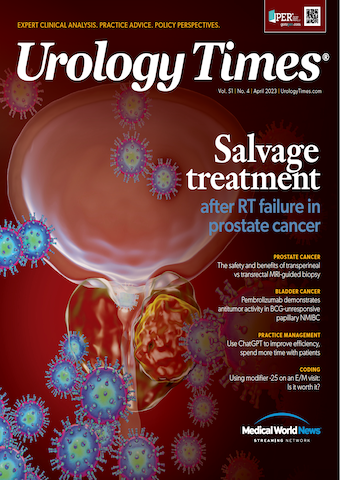Publication
Article
Urology Times Journal
Using modifier –25 on an E/M visit: Is it worth it?
Author(s):
Modifier -25 is defined as a significant, separately identifiable E/M service by the same physician or other qualified health care professional on the same day of the procedure or other service.
Jonathan Rubenstein, MD

Over a number of years, we have seen increased scrutiny over the use of a separate and identifiable evaluation and management (E/M) service using modifier -25 on the same day as another service or procedure. Practices have become burdened with a significant uptick in insurers who demand documentation of such services both after and before payment. This has led to a huge administrative burden for many urology practices. Why is this? Is it because there is an actual overuse of such services? Or is this purely a business decision from insurers and maybe even hoping that this is a game of attrition in which the payers hope to eventually see practices stop reporting E/M services on the same date of service as procedures to save money in the long term?
Unfortunately, we have heard that several groups have decided that the amount of work and cost required to obtain the appropriate reimbursement is too much and they have either stopped billing E/M services on the same date and have chosen to provide free care, or to simply make the patients return on a different date for that portion of their care. Certainly, this is not ideal and is burdensome on both patients and practices, leading to delays of care and patient inconvenience. The rules were put in place so that services would be paid appropriately when billed in an appropriate manner.
Mark Painter

From the payer side, modifier -25, which is defined as a significant, separately identifiable E/M service by the same physician or other qualified health care professional on the same day of the procedure or other service, has been a subject of targeted review for several years after an initial report by the US Department of Health & Human Services Office of the Inspector General indicated that modifier -25 was incorrectly reported in 35% of cases reviewed in 2005. Recently, payers reviewing charts have found a lack of documentation or lack of medical necessity in enough to warrant spending their resources to increase the review of charts with modifier -25. Additionally, it is likely that the initial reviews are being processed by a computer assisted coding tool using advanced computer recognition and processing tools to improve the speed of chart review and adding coding personnel to increase the number of charts they are able to review. Both are an investment by the payer that must pay dividends in both the short and long term.
Is it right to change your practice methods or start giving away services in an environment of stagnant reimbursement and higher cost? Can your office’s infrastructure support the increased work? Or are there other ways to address this issue?
Before we get into solutions, we should review the reporting rules for modifier -25, which per the Current Procedural Terminology (CPT) definition are described as the following:
“It may be necessary to indicate that on the day a procedure or service identified by a CPT code was performed, the patient’s condition required a significant, separately identifiable E/M service above and beyond the other service provided or beyond the usual preoperative and postoperative care associated with the procedure that was performed. A significant, separately identifiable E/M service is defined or substantiated by documentation that satisfies the relevant criteria for the respective E/M service to be reported (see Evaluation and Management Services Guidelines for instructions on determining level of E/M service). The E/M service may be prompted by the symptom or condition for which the procedure and/or service was provided. As such, different diagnoses are not required for reporting of the E/M services on the same date. This circumstance may be reported by adding modifier -25 to the appropriate level of E/M service.”
From Medicare Processing Rules from Medicare Claims Processing Manual Chapter 12 – Physicians/Nonphysician Practitioners30.6.6.B. CPT Modifier “-25” – Significant Evaluation and Management Service by Same Physician on Date of Global Procedure:1
“Medicare requires that Current Procedural Terminology (CPT) modifier -25 should only be used on claims for evaluation and management (E/M) services, and only when these services are provided by the same physician (or same qualified nonphysician practitioner) to the same patient on the same day as another procedure or other service. A/B MACs [Medicare Administrative Contractors] (B) pay for an E/M service provided on the day of a procedure with a global fee period if the physician indicates that the service is for a significant, separately identifiable E/M service that is above and beyond the usual pre- and post-operative work of the procedure. Different diagnoses are not required for reporting the E/M service on the same date as the procedure or other service. Modifier -25 is added to the E/M code on the claim.
Both the medically necessary E/M service and the procedure must be appropriately and sufficiently documented by the physician or qualified nonphysician practitioner in the patient’s medical record to support the claim for these services, even though the documentation is not required to be submitted with the claim.
If the physician bills the service with the CPT modifier ‘-25,’ A/B MACs (B) pay for the service in addition to the global fee without any other requirement for documentation unless one of the following conditions is met:
• When inpatient dialysis services are billed;
• When preoperative critical care codes are being billed on the date of the procedure, the diagnosis must support that the service is unrelated to the performance of the procedure; or
• When an A/B MAC (B) has conducted a specific medical review process and determined, after reviewing the data, that an individual or a group has high use of modifier ‘-25’ compared to other physicians, has done a case-by-case review of the records to verify that the use of modifier was inappropriate, and has educated the individual or group,
A/B MACs (B) may not permit the use of CPT modifier ‘-25’ to generate payment for multiple evaluation and management services on the same day by the same physician, notwithstanding the CPT definition of the modifier.”
We are all aware that private insurers have some ability to adopt rules that are different from those published by Medicare. Based on a settlement from a class action lawsuit against several of the Blue Cross and Blue Shield organizations in 2007, private payers are required to be more transparent in their rules as they pertain to CPT and Medicare. Many groups contracted with these payers have agreed to rules as stipulated by the contract and published by the payer. For the purposes of this article, we focus on Medicare and CPT but encourage you to review your high-volume payer rules.
Applying the definition and Medicare rules, there are a few basics that need to be considered for the clinical aspects of the visit and, separately, you will need to consider the supporting documentation and presentation of the reason for the service, the effort, and of course, the findings. We provide the following as a top 5:
1. Payment for procedures/services for the vast majority of services include preservice work, the service itself, postservice care, and explaining to the patient the results of the service. If the work provided for the patient is included in these basic categories and is within the “global” period for that payer, you should not bill for an E/M service in addition to the service/procedure.
2. Provision of any service to a patient requires that the patient and any related caregivers are in a condition to properly receive and understand the services provided and, importantly, participate in any further management decisions of care. If the patient is not alert enough to participate in an E/M service, it should not be reported.
3. Provision of any service must meet medical necessity thresholds. Any E/M service provided to a patient at any time must be medically necessary and supported by documentation that explains to any reviewing entity the need and appropriateness of the care provided. If a medically necessary E/M service is provided on the same date as the encounter, clearly document the reason for the visit and consider whether the E/M service was medically appropriate and necessary considering what your urology peers would say.
4. E/M services with modifier -25 appended must conform to the CPT definition and the payers rules. For Medicare, this means the following:
A. Append modifier -25 to E/M codes provided on the same date of the procedure/service by the same physician/advanced practice provider. For groups, Medicare will consider services within the same group and same specialty as provided by the same physician in most cases. Do not append the modifier -25 to non-E/M service codes or for E/M services that are provided on the same date as services that do not have a global, such as radiology services, lab services, and certain diagnostic tests like post-void residual.
B. Documentation must support the E/M service. Complying with this stipulation can be more clearly demonstrated with a well-designed note that literally separates the procedure from the E/M service, which will help both the computer and the coder more readily accept the E/M services provided were not a part of the pre- or postservice work. Computer programs are based on key phrases and formats as trigger points for computation. Coders are also trained to identify key phrases and formats. Consider adding modifier-specific language to separate and highlight the unique services provided and consider spacing, paragraph changes, or pagination to separate services provided.
C. A separate diagnosis is not required for the use of modifier -25; however, a separate diagnosis is more easily identified as separately identifiable if the service is provided for a different problem represented by a separate diagnosis. Therefore, if the services are provided for different diagnoses, make sure documentation and billing are appropriately documented and communicated.
5. Establish an internal review process to look at samples of notes for each provider to make sure that modifier -25 is justified and that any documentation submitted includes the necessary information to pass a chart review. If you submit documentation that supports payment for 100% of encounters reviewed, you now have a case to go the payer explaining the futility of chart review for your practice. Do not be timid about pushing your provider rep with any insurance company, but you will need data, a clear plan, and/or market dominance for urology services to persuade a payer to change.
We did not include the path of least resistance in our top 5 actions. It is an option to simply stop charging for the E/M work you are doing on the same date as procedures; for some groups, this may be the only option because of staff size. However, we would encourage you to run your numbers considering both the short- and long-term consequences. For an example, we will assume an even split of 99213 and 99214; therefore, an average payment for an established patient office visit is $109.63. If the group averages 10 visits per week that they choose not to submit because the payer is requesting documentation for -25 E/M services, they are giving up $4385 per month in revenue, and the only work you are reducing is the follow-up for payment. Assuming it takes 10 minutes for each chart submission—a generous number—you are now tasked with finding 7 hours of labor and that associated cost to get the money you deserve for the work you are already doing. It is an expense that cannot be ignored.
Another approach is to schedule patients for E/M follow-up on a separate date of service. This approach also has consequences, including continuity of care, additional copays for patients, and the incremental expense of a second office visit or telehealth visit. On the plus side, you are creating an ally in the patient, who can help with policy change. Again, we encourage you to estimate the impact to the practice before implementing a change of this type.
Some may be able to drop plans that implement these policies if they do not represent a significant portion of your patients.
On a broader scale, class action suits and/or state legislative action could be considered for a long-term solution to these potentially significant burdensome chart requests. We would add prior authorization reform to attempt a “twofer” with this course.
And as an example, many urology practices have recently received letters from Cigna indicating that it will require submission of documentation with all established patient E/M visits submitted with a modifier -25 on the same date as a minor procedure beginning in May 2023. It is important to consider all options and one’s practice’s capacity to perform this level of submissions to see if a change in one’s practice is needed, which may be necessary even if patients feel they are the pawns in the game their insurer is playing with them. Then we can encourage them to reach out to their insurers to complain about their payer policies. In the long run, it is our opinion that modifier -25 is worth the battle.
Reference
1. Medicare Claims Processing Manual Chapter 12 - Physicians/Nonphysician Practitioners. Centers for Medicare & Medicaid Services. February 2, 2023. Accessed March 30, 2023. https://bit.ly/3zC5KYd

































